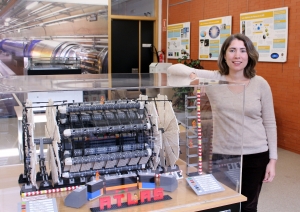Arantxa Ruiz returns to IFIC with a Ramón y Cajal contract to deepen the study of the Higgs boson
She has been responsible for coordinating the so-called 'trigger menu' of the ATLAS experiment during 2018, the last year of the LHC Run 2. In March 2018 she began her 'Ramón y Cajal' contract at the Instituto de Física Corpuscular (IFIC, CSIC-UV), where she received her doctorate in 2009 with a thesis on the decays of the Higgs boson to muons when the LHC was about to start. After a decade at CERN contributing to the operation of ATLAS and participating in numerous physics analyses, Arantxa Ruiz Martínez returns to IFIC to deepen the study of the Higgs boson. Her goal: finding pairs of Higgs bosons to measure how the particle interacts with itself.
Arantxa Ruiz Martínez (Girona, 1980) graduated in Physics at the University of Valencia (2003), doing her PhD at IFIC on the development of the hadronic calorimeter of ATLAS, one of the two large detectors of the LHC that was being built in those years. The researcher worked on the implementation of various algorithms designed to detect muons in the calorimeter readout electronics, electron-like but heavier elementary particles. In addition, she analyzed the possibility of detecting the longed-sought Higgs boson in decays to these particles with the LHC yet to begin operating.
After completing her PhD thesis in 2009, Arantxa Ruiz moved to CERN to work in ATLAS, first as a postdoctoral research associate at Iowa State University (USA), then as a research fellow at CERN and then with the University of Carleton (Canada). During this time the Higgs boson was discovered, the piece that culminates the theory describing elementary particles and their interactions, the Standard Model.
In the last year of Run 2, the second operating cycle of the LHC (2015-2018), the researcher was in charge of coordinating the ATLAS trigger menu, consisting of all the event selection algorithms used during data taking. The trigger system is responsible for selecting in real time the collisions that are saved for further analysis: of the 40 million collisions per second that occur inside ATLAS, only 1,000 are stored on disk, discarding the others.
This role, a level 2 position in the ATLAS' management structure, involves being at the forefront of the operation of the experiment, operated by a collaboration of more than 3,000 scientists. It is a question of recording the most valuable collisions that may correspond to physical processes of interest (such as the Higgs boson or new physics beyond the Standard Model) taking into account the limitations of computing, the rate of events affordable by the data acquisition chain and storage.
At the end of this responsibility, Arantxa Ruiz Martínez rejoined IFIC in October of this year. “I decided to return to IFIC because it is one of the most important groups within the ATLAS collaboration", she recalls. “In addition, it is a leading center in experimental particle physics, with participation in many experiments". As a Ramón y Cajal researcher, Ruiz collaborates with the ATLAS group of the IFIC, now immersed in the development of the new components for the hadronic calorimeter and the tracking detector of the experiment that will be installed for the next phase of the LHC, called High Luminosity LHC (HL-LHC), from 2023. And she continues to delve into the study of the Higgs boson.
The researcher looks for whether the Higgs interacts with itself, as predicted by the Standard Model Brout–Englert–Higgs mechanism, or if there are other mechanisms that would point to the existence of 'new physics'. So far this phenomenon has not been observed in the LHC, but it may be only a matter of statistics. According to Ruiz, it would take about 3,000 inverse femtobarns (measurement of the number of collisions) to obtain evidence of this process, although it could happen much earlier if there were new physics that increases this interaction. That amount of data will be reached at the end of the HL-LHC, around 2035. During Run 2, 147 inverse femtobarns were obtained, and 173 for the two operating cycles of the LHC since 2010.
References:
ATLAS Collaboration, Performance of the ATLAS Trigger System in 2015, Eur. Phys. J. C 77 (2017) 317, arXiv:1611.09661 [hep-ex].
ATLAS Collaboration, Trigger menu in 2018, ATL-DAQ-PUB-2019-001, 2019.




















